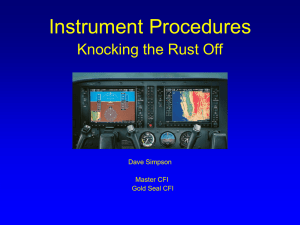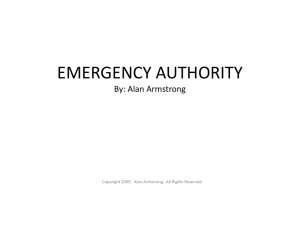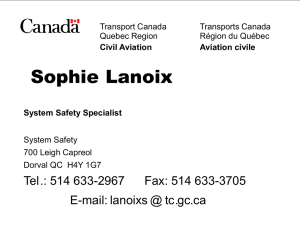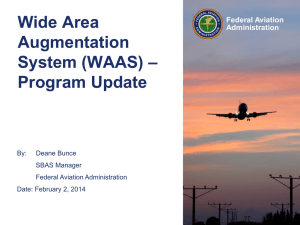1 - Society of Aviation and Flight Educators
advertisement
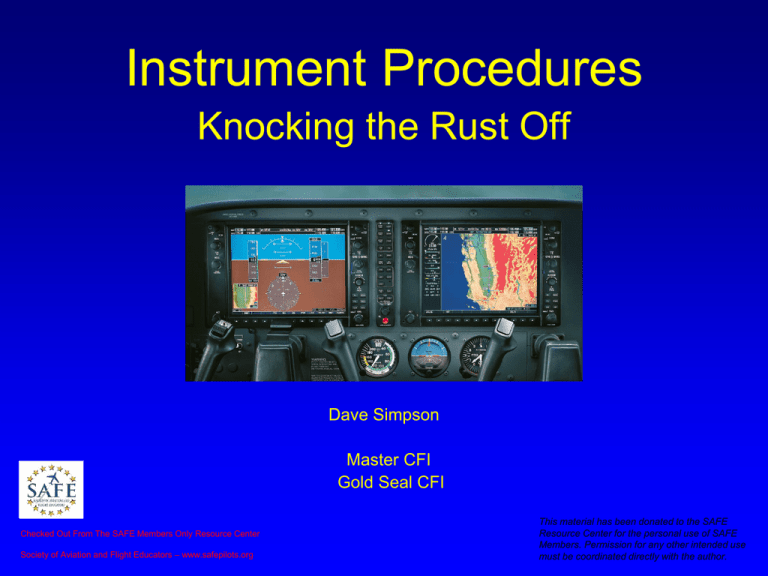
Instrument Procedures Knocking the Rust Off Dave Simpson Master CFI Gold Seal CFI Checked Out From The SAFE Members Only Resource Center Society of Aviation and Flight Educators – www.safepilots.org This material has been donated to the SAFE Resource Center for the personal use of SAFE Members. Permission for any other intended use must be coordinated directly with the author. Objectives • Review IFR procedures - some new stuff in the FAR, AIM, ACs • Discuss WAAS implications for preflight, approaches and alternates • Review of charts, hold entries, lost com • Common IFR misconceptions • Local “issues” from MYF & SEE Towers Preflight IFR Requirements 91.103 Preflight Action for Flight Under IFR What You Need to Know Before You Go • Runway Lengths (VFR Too) • ATC Delays – required part of standard briefing • Weather (Icing?) • Fuel Requirements (What Are They?) 91.167 Are we done yet? Preflight IFR Requirements • Fuel requirements for flight in IFR conditions. (a) No person may operate a civil aircraft in IFR conditions unless it carries enough fuel (considering weather reports and forecasts and weather conditions) to-(1) Complete the flight to the first airport of intended landing; (2) Except as provided in paragraph (b) of this section, fly from that airport to the alternate airport; and • (3) Fly after that for 45 minutes at normal cruising speed • Alternates • Takeoff & Landing Distances (VFR Too) Are we done yet? Preflight IFR Requirements You are about to depart under IFR and find that your VSI is inoperative …. 1.Can you legally depart IFR? 91.205 2. Does anything still need be done? 91.213 Are we done yet? Preflight GPS Operations For GPS Operations – TSO 129 Equipment • Must do a RAIM Prediction Check “If TSO-C129 equipment is used to solely satisfy the RNAV requirement, GPS RAIM availability must be confirmed for the intended route of flight (route and time) using current GPS satellite information.” AC 90-100 • Both departure (if flying an RNAV DP) and destination airports must be checked. • RAIM must be predicted to exist continuously during the planned flight “In the event of a predicted, continuous loss of RAIM of more than five (5) minutes for any part of the intended flight, the flight should be delayed, canceled, or re-routed where RAIM requirements can be met.” AC 90-100 GPS Operations How Can A RAIM Check Be Done? • Call Flight Service (within 24 hours of ETA) • Go to www.raimprediction.net (FAA Site) • Complete a RAIM check on your GPS • GPS provides 10 meter accuracy OK … But What About WAAS? WAAS Operations WAAS Operations • Certified Under TSO C145 & C146 • Uses the 24 GPS satellites • 2 Geostationary Satellites • 25 Ground Reference Stations • 2 Master Correction Stations • 4 Ground Uplink Stations How Does WAAS Work? 2 Geostationary WAAS Satellites 5 24 GPS Satellites 1 4 Aircraft 2 2 Master Stations 25 Ground Stations 3 Ground Uplink Stations WAAS Operations • Faster refresh rates 5x/sec vs 1x/sec for GPS • 3 meter accuracy vs 10 meters for GPS • Vertical Guidance (2,397 LPV approaches) more LPV than ILS Approaches now • WAAS will fly procedure turns with a roll steering AP • Can use WAAS as single source navigation (FDE) • Not required to check for RAIM before flight, unless flying outside US airspace, or where WAAS coverage doesn’t exist • Are required to check NOTAMS for WAAS outages with Flight Service “Outside the U.S. or in areas where WAAS coverage is not available, operators using TSO-C145/C146 receivers are required to check GPS RAIM availability.” AC 90-100 WAAS Operations • LPV minimums down to 200’ if there is also a parallel taxiway, a minimum of a MALSR approach lighting system and precision runway markings • Lacks the precision required for Cat II and III approaches GPS and WAAS Operations What Happens If RAIM is Lost During Flight? • Must notify ATC immediately AIM 5-3-3 • Must revert to alternate means of navigation AC 90-100 GPS and WAAS Operations What Happens if RAIM is Lost on Approach? e.g. RAIM Warning Appears on GPS RAIM Availability Computed at 2 NM Before FAF • If inside the FAF you can continue (no warnings for 5 min) • If outside the FAF you must discontinue the approach AIM 1-1-19 Alternates You always file an alternate unless you can meet 1 hr before to 1 hr after ETA 91.169 2,000’ ceiling AND 123 Rule 3 miles visibility • What if destination has no approach? • What if alternate has no approach? • Does my equipment affect alternate filing? Alternates • If destination has no approach, you must file an alternate regardless of weather CFR 91.169 • If alternate has no approach, you must be able to descend from the MEA, approach, and land under VFR CFR 91.169 • If only GPS equipped, alternate cannot have only GPS approaches (alternate needs VOR/LOC) AIM 1-1-19 • If WAAS equipped, this restriction is removed so a single WAAS receiver is legal AIM 1-1-19 Alternates Scenario: Tower Enroute Practice Approach from MYF to CRQ. Aircraft WAAS equipped. Weather at CRQ is 1,500 scattered and 2 miles visibility. Can you legally take off? Yes No Alternates Scenario Continues: You determine that under the 123 rule, you need an alternate and have decided that you will use the LOC D approach at SEE as your alternate. The weather at SEE for your ETA is 1,500 SCT 1,200 OVC 2 SM VIS. Can you legally file SEE as your alternate? Yes No Depends on the approach Alternate Minimums Section Non Standard Alternate Minimums SAN DIEGO(EL CAJON), CA GILLESPIE FIELD ............................... LOC-D¹² RNAV (GPS) Rwy 1734 ¹NA when control tower closed. ²Categories A, B, 2400-2; Categories C, D, 2400-3. ³Categories A, B, 1100-2; Category C, 1100-3; Category D, 1200-3. 4 NA when local weather not available. GPS In Lieu of DME Can GPS be used as a substitute for DME? Yes, as long as it is WAAS No, if it says DME it must be DME Yes, as long as it is a panel mount, IFR certified receiver (either GPS or WAAS) Using GPS to Assist Approaches Can GPS be used to fly a non GPS approach where RNAV(GPS) is not included in title e.g. VOR A OKB, LOC D SEE, ILS 28 MYF? Yes, if the approach is in the database No, under any conditions Yes but only some parts AIM 1-2-3 Pilots may not substitute for the NAVAID (for example, a VOR or NDB) providing lateral guidance for the final approach segment. Solving Chart Mysteries Chart Mysteries What does the name on the chart mean vs. the notes on the chart? Chart Mysteries Scenario: You’re flying today under IFR to CRQ and notice that your GPS database is not current. You look at the following current approach chart. Can you still conduct the RNAV (GPS) 24 approach under IFR? Yes No Who cares – this is starting to get boring! 10098 Last change of any kind Last Lastprocedure Procedure change Change 10098 Chart Mysteries Scenario: You’re 5 miles from OCN (See Following Chart) at 4,000’ on the VOR A and ATC says, cleared VOR A approach. You are cleared to descend to 2,500 You must fly to OCN at 4,000 then descend to 2,500 You can do either if you’re WAAS equipped Chart Mysteries Scenario: You want to practice approaches and get a TEC clearance to OKB from SEE. Weather at SEE is 300 OVC and 1 mi VIS. You accept the clearance which includes the published departure procedure and are ready for takeoff. Is there anything else you need to check? No, I am cleared to go by ATC No, I am flying Part 91 and can go zero-zero Yes, but I only need to meet the climb gradient What are standard takeoff minimums? What criteria requires an ODP to be published? 91.175 (f) Civil airport takeoff minimums. This paragraph applies to persons operating an aircraft under part 121, 125, 129, or 135 of this chapter.(1) Unless otherwise authorized by the FAA, no pilot may takeoff from a civil airport under IFR unless the weather conditions at the time of takeoff are at or above the weather minimums for IFR takeoff prescribed for the airport under part 97 of this chapter AIM 5-2-8 Climb gradients greater than 200 FPNM are specified when required to support procedure design constraints, obstacle clearance, and/or airspace restrictions. Compliance with a climb gradient for these purposes is mandatory when the procedure is part of the ATC clearance, unless increased takeoff minimums are provided and weather conditions allow compliance with these minimums. Chart Mysteries Scenario: You’re on the ILS at MYF and reach the DA of 623’. You look up a see one approach light. What are your options? TDZE is 423’ CFR 91.175 Immediately conduct a missed approach Descend to 523’ and look again Ask ATC what to do Chart Mysteries Chart Mysteries Scenario Continued: You have descended to the TDZE of 563’ and now see the runway numbers, threshold lights, and about 1/3 of the runway length of 4,577’. Now what? Immediately conduct a missed approach Land. I see two of the required things Open the FAR/AIM and start reading CFR 91.175 (C) 2 The flight visibility is not less than the visibility prescribed in the standard instrument approach being used. Chart Mysteries RNAV Approach Types LP .1 LNAV .6 LPV (WAAS) LNAV/VNAV (WAAS) LNAV+V (WAAS) LNAV (GPS) LP (WAAS) GLS (GNSS) LAAS (SBAS) Operations • Approach Chart Title: GLS (Global Navigation Landing System) • Allows for Cat I, II and III approaches, 1 meter accuracy • Allows for curved path approaches • Serves all of the airports runways (cheaper than an ILS) • Makes unmanned landing possible LAAS (SBAS) Operations Chart Mysteries What does this symbol mean? Required Reports • 91.187 Under IFR any com, nav, or approach malfunction • 91.183 Any unforecast weather • AIM 5-3-3 (IFR or VFR) • Leaving a previously assigned altitude (without ATC) • When unable to climb or descend at least 500 fpm • When an approach has been missed • Change in filed TAS of 5% or 10 kts whichever is greater • Reaching or leaving a holding fix • Anything that affects safety of flight Safety Pilot What qualification does your safety pilot need? Current medical? Pilot certificate with category & class ratings? Current flight review? Current for day or night landings? Qualified to act as PIC in the aircraft? Only 2 Safety Pilot Qualifications • Must have a current medical CFR 61.3 A person may serve as a required pilot flight crewmember of an aircraft only if that person holds the appropriate medical certificate issued under part 67 of this chapter, or other documentation acceptable to the FAA, that is in that person's physical possession or readily accessible in the aircraft. • At least a private pilot with category and class ratings CFR 91.109 No person may operate a civil aircraft in simulated instrument flight unless the other control seat is occupied by a safety pilot who possesses at least a private pilot certificate with category and class ratings appropriate to the aircraft being flown. Who Can Log Flights? Scenario: Bob is a private pilot, instrument rated and current. He decides to go flying in instrument weather with his friend Dave who is a private pilot with no instrument rating. They agree that Dave will do all the flying, including approaches, and landing. Is this a legal flight? If so who can log it? Not legal. The pilot flying needs an instrument rating Legal, but they’re both crazy Logging vs Acting as PIC Definition of Pilot in Command (CFR Part 1) Pilot in command means the person who: (1) Has final authority and responsibility for the operation and safety of the flight; (2) Has been designated as pilot in command before or during the flight; and (3) Holds the appropriate category, class, for the conduct of the flight. Logging vs Acting as PIC Who Needs an Instrument Rating (CFR 61.3 e) • No person may act as pilot in command of a civil aircraft under IFR or in weather conditions less than the minimums prescribed for VFR flight unless that person holds the appropriate aircraft category, class, type (if required) and instrument rating on that person’s pilot certificate Logging Pilot in Command Time (CFR 61.51 e) A sport, recreational, private, or commercial pilot may log pilot-in-command time only for that flight time during which that person is the sole manipulator of the controls of an aircraft for which the pilot is rated Logging vs Acting as PIC • Logging and acting as PIC have nothing at all to do with one another. • To log PIC time you only need to be the sole manipulator, and have category and class ratings – don’t need a medical, flight review or anything else Lost Com Do nothing for a minute – try previous, next, FSS freq Squawk 7600 and proceed VFR to land if possible Route Guidance Assigned - Route assigned in the last clearance Vectors - if radio failure occurred while being radar vectored, then proceed by a direct route to the fix route, or airway specified in the vector clearance Expect - by the route that ATC advised may be expected Flight Plan – proceed via your flight plan if the above doesn’t apply Lost Com Altitude Guidance Highest of the following altitudes • Altitude assigned in the last clearance • Minimum IFR altitude MEA or OROCA • Altitude ATC advised may be expected Lost Com Cessna 1234, cleared to the Oceanside airport, after departure turn right heading 340, expect radar vectors to OCN. Climb maintain 3,000, expect 4,000 in 10 min On a heading of 340, at 3,000’ we lose com What is the route? What is the altitude? Our ETA at OKB is 1700Z. When would we leave the hold at OCN Paper or Plastic Charts? Are charts of any kind required by regulation? Electronic charts are governed by AC 91-78 6. REMOVAL OF PAPER FROM THE COCKPIT FOR OPERATIONS UNDER PART 91. EFBs/ECDs can be used during all phases of flight operations in lieu of paper reference material when the information displayed meets the following criteria: Paper or Plastic Charts? • (1) The components or systems onboard the aircraft which display • precomposed or interactive information are the functional equivalent of the paper reference material. • (2) The interactive or precomposed information being used for navigation or performance planning is current, up-to-date, and valid. » Class 1 Device – Portable » Class 2 Device – Mountable » Class 3 Device - Installed Right Hold Entries 110° Parallel 70° Tear Drop 180° Direct Left Hold Entries 70° Tear Drop 110° Parallel 180° Direct And Now a Word From the Tower And Now a Word From the Tower Gillespie Tower • Be familiar with the SEE ODP – too many pilots when given it go … Huh? • Don’t show up on the SEE LOC D while other aircraft are commencing the approach • Please don’t fly the LOC backwards, opposite the direction of approaches!! • Be familiar with how close MYF is to SEE. Call us before busting our airspace And Now a Word From the Tower • Montgomery Tower • Don’t file a TEC route with the tower without determining if you need an alternate. • Remember that even if you file an alternate neither the tower or ATC has it • IFR to VFR On Top will always go to either MZB-RYAAH (South) or OCN (North) • On Top clearances will not be available if the cloud tops are above 3,500’ Garmin 430/530 Training www.flighttrainingapps.com Garmin 430/530 Training www.flighttrainingapps.com Garmin 430/530 Training www.flighttrainingapps.com Garmin 430/530 Training www.flighttrainingapps.com This presentation can be downloaded at www.takeflightsandiego.com Contact the author at: dave@TakeFlightSanDiego.com 858-2547504 www.TakeFlightSanDiego.com
